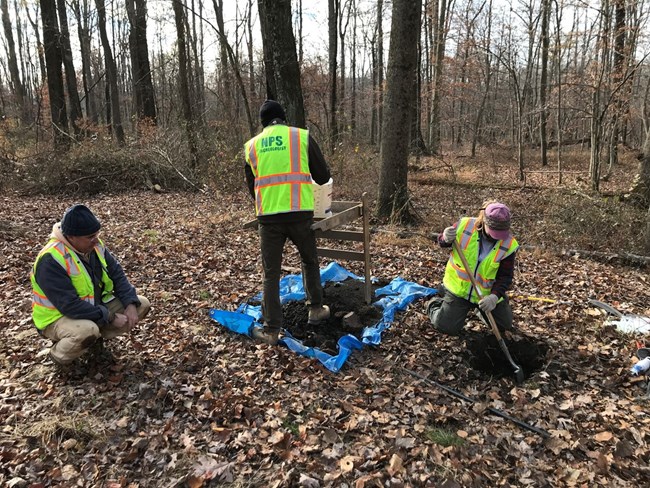
NPS photo//NARP - Northeast Archeological Resources Program The African American Experience at Hopewell FurnaceMuch is unknown about the lives of African Americans at Hopewell Furnace. Historical evidence suggests a complex story that is connected to themes of oppression, defiance and determination. In many ways, the unknown aspects of these stories speak volumes about racial inequality and imbalances with how the past is remembered. Additional research is needed to improve our understanding of all the lives of Hopewell’s workers and residents. Hopewell Furnace (c.1771 to 1883) was established by Pennsylvania businessman, Mark Bird. In 1780, Bird enslaved the most persons in Berks County, profiting from the enslaved labor of 10 men, 4 women, 3 boys and 1 girl. Because Mark Bird never lived at Hopewell Furnace, it is unknown if his enslaved persons worked or lived at Hopewell. It is also unknown if the enslaved persons of subsequent owners of the furnace lived or worked at Hopewell. One of the last records that show the connection of Hopewell Furnace and enslaved labor involves Matthew Brooke freeing 1 of his enslaved persons in 1821. After 1821, the historical record shows indentured servants were used as well as labor of free African Americans. Free African Americans were only hired as unskilled and semiskilled workers in jobs such as woodcutters, laborers and teamsters. In Hopewell’s 112-year history, there is no record showing African Americans working in management or skilled labor positions. Hopewell Furnace employed workers from surrounding communities. In 1780, Pennsylvania passed an abolition act that ordered a form of gradual emancipation for enslaved persons. As a result, Pennsylvania had a growing African American community by the 19th century. In 1856, an African American community at Six Penny Creek established an African Methodist Episcopal Church on land owned by the family of a free African American, Issac Cole. It is believed this church served as a stop on the Underground Railroad and as the site of the oldest known African American cemetery in Berks County. The tombstones in the cemetery record the burial of many African Americans who worked at Hopewell Furnace. Nevertheless, there is no documented evidence showing Hopewell Furnace was directly involved with the Underground Railroad. Beginning in 1934, Civilian Conservation Corps (CCC) camps developed French Creek Recreational Demonstration Area in northeastern Pennsylvania. This project led the National Park Service to examine the historical significance of Hopewell Furnace. In 1938, Hopewell Furnace was designated as a National Historic Site. Some of the first people employed to reconstruct and preserve the site were members of the CCC. This public work relief program employed young males, World War I Veterans and local skilled workers from across the country. The CCC was segregated and African Americans were not a part of the two CCC camps that were stationed at Hopewell. The injustices of racial segregation contributed to the exclusion of African Americans from telling the story of the United States’ industrial past. It is essential to learn about these historically overlooked stories to gain a better understanding about the communities who lived and worked at Hopewell Furnace. Over the last several years the park service has conducted multiple archeological excavations within the boundaries of the park where African American families were known to reside. Through partnering with local universities, students have utilized census records and other data to expand on individual life stories. We anticipate more information related to these projects becoming available to the public shortly. With each new project we gain a better understanding of how people experienced life differently based on their ethnic and racial backgrounds. In so doing, Hopewell Furnace is better able to connect local stories to the larger narrative of the United States’ industrial history. Mount Frisby African Methodist Episcopal ChurchIn 1856 the African American community at Six Penny Creek established an African Methodist Episcopal Church on land owned by the Cole family. This church served as a station stop on the Underground Railroad and as the site of the oldest known African American cemetery in Berks County. The tombstones in this cemetery record the burial of many African Americans who worked at Hopewell Furnace. The cemetery, carefully restored and maintained by the Cole family, serves as a silent reminder of the once thriving African American community that helped fuel the iron industry in southern Berks County.
NPS Photo montage used with permission of Barbra and John Cole |
Last updated: February 4, 2025
